You have read about “the good” Islamabad in Part 1 of this post, which, it seemed from the comments, sent some of you reminiscing about the Islamabad that you knew. Well, here is the not-so-good and the ugly side of Islamabad as seen by me and my camera.
In Part 1 of this series on Islamabad, I had said that there were certain things that ‘self-respecting’ Pakistanis won’t do. Riding a bicycle and carrying anything heavier or larger than a briefcase were two of them. I would like to add one more thing to this list: no proud Pakistani would like to be seen stopping or slowing down his/her car at a crosswalk or ‘zebra crossing’ to allow a pedestrian to cross the road peacefully. Even the cars that are turning from a side street would barrel down at the pedestrians forcing them either to run for their lives – literally – or scurry back to safety.
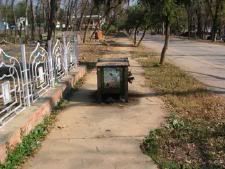
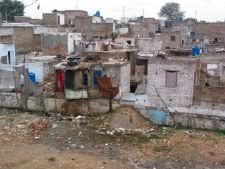
I find it ironic that on the one hand we take so much pride in our cultural values of courtesy, hospitality, lehaaz and “pehlay aap” – and often flaunt them – and on the other hand the moment we get inside a car we toss all those values out, just as we routinely toss candy wrappers and other trash out of our car windows. I have never understood this sudden transformation.
But come to think of it, many of the crosswalks in Islamabad often end up nowhere, anyway –some against a high road divider and others in a ditch. Yes, in a ditch, as can be seen in the pictures here. So, if even you escape the speeding car you may end up tripping over or, worse, in a ditch!
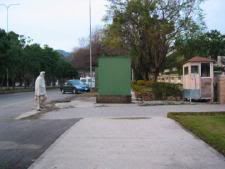
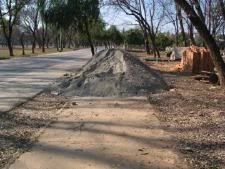
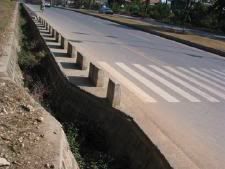
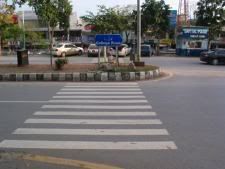
Another thing that would frustrate a newcomer to the town is the lack of adequate and continuous sidewalks. An advertisement supplement on “Destination Pakistan 2007” in last Sunday’s Daily Times boasts:
The master plan of this most modern city was prepared in 1960. Islamabad is one of the few planned cities of the world… It is a modern and a carefully planned city, with tree-lined streets, large houses, elegant public buildings and well organized bazaars.
Yes, it has tree-lined streets and large, in fact very large, houses but this “most modern” and “one of the few planned cities of the world” does not have adequate sidewalks. The sidewalks that are there in the “prestigious” E and F sectors are often blocked by construction material dumped on them and cars parked on them (who said there were no idiots in these sectors?) or, as if this wasn’t bad enough, large transformers installed in the middle of sidewalk by WAPDA. The Greek planners of the city obviously did not factor in Wapda’s ingenuity when planning the city.
It’s a bit ironic that the people, who invented the automobile and manufacture and use it in millions, always build adequate sidewalks for foot traffic in their cities and keep the sidewalks unobstructed both for able bodied as well as for disabled individuals and their motorized or manually pushed chairs. And we, who acquired automobiles relatively recently, totally ignore the need of pedestrians, let alone those of the handicapped.
You cannot see or appreciate a city while driving – or reading about it in newspaper supplements. To take in the sights, sounds and smells of a city you have to be able to walk around without the fear of tripping over, falling in a ditch or being run over. And one finds it very difficult to do that even in Islamabad – “one of the few planned cities of the world”. With all those hurdles placed in one’s way, one has to be a kangaroo to be able to walk around the city. The city planners obviously overlooked something very important and elementary.
Barring the frustration a pedestrian has to go through, Islamabad is mostly a clean city – in fact, very clean by Pakistani or third world standards. Its streets are regularly swept; its drains and sewers rarely overflow; the domestic trash is dutifully picked up from in front of the houses and deposited in the garbage bins and, before the bins start overflowing, they are emptied by garbage trucks.
And who does all this “dirty work”? An army of sanitary staff, men and women, distinguishable by the yellow jackets they wear as their uniform, is employed by the Capital Development Authority (CDA) to keep the city clean. Theirs is one of the most arduous jobs and they provide one of the most essential services a city has to have to survive. Incidentally, Islamabad will not know the difference if all the government offices were closed for a week or so, which they actually are during Eid and Muharram holidays. But if the sanitary workers stop working for a week the city will turn into a garbage dump. Despite that they are the lowest paid and most discriminated of the City employees.
It is very ironic that these workers, who keep the city clean and running, themselves live in squalor in some of the worst slums in most unhygienic conditions – right in the middle of two of the prestigious sectors (F-6 and F-7). Their houses consist of clusters of shanties without adequate drainage or dependable water, power and gas supply. The City has tried to hide these slums from the surrounding localities by building high walls around them, just as one would try to mask a blemish on his/her face. But, is that a solution?
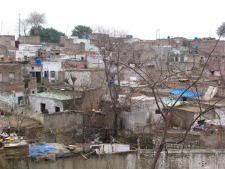
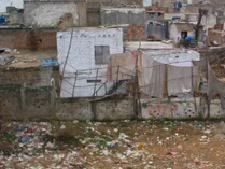
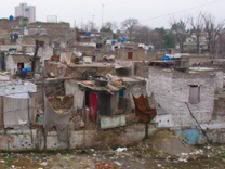
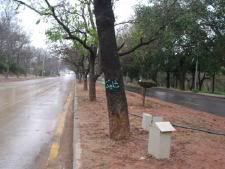
One wonders, why can’t the City, which spends billions of rupees on widening the roads, building public buildings and government housing, playgrounds, parks and expensive monuments (some of them totally wasteful) can’t provide low cost housing to these employees? Something on the lines of Project Housing in New York city or other cities of the world.
Since majority of these workers happen to be Christians they are doubly discriminated. They are excluded from receiving any Zakat money from the government collectively or individually. Private Muslim charities also exclude them for religious reasons. Nor do they even receive sacrificial meat on Eid al-azha.
Very close to the shanties, at a higher level, there is a beautiful, tree-lined, dual carriage road. Nailed to the trees are green metal plates, each bearing one of the attributes of God and the Prophet. Such names and other religious writings were nailed to the trees and lampposts in Islamabad, as in many other cities, in a spate of conspicuous religiosity that hit Pakistan in the last 20 years or so. Included among the sacred names are also al-Rehman (the beneficient), al-Razzaq (the provider) and al-Karaim (the bountiful and generous). I wonder if the people in the shanties who also keep this road clean ever noticed these names and their significance.
Note: Part 1 of this article here. All photographs by author.




















































[quote post=”588″]What about the madrassas that are squatting on some of the most expensive real estate in Islamabad? Why doesn’t the administration move them to the H sector, which is specifically meant for educational institutions? Why a soft corner for one group and total callousness for the other? And, incidentally, sanitary workers are essential for the survival of Islamabad. Madrassas are not.[/quote]
Ah, yes… I believe they started doing that too but the illegal occupation of the school library near Aabpara made national news…
I stand firmly behind the stance that the administration should tear down any mosques which were/have been/are being made illegally. The Sunnah of the Prophet (PBUH) clearly shows that the land must be purchased before a Mosque can be made on it.
Come to think of it, if you want to move someone out of Islamabad because they are wasting ‘prime real estate’, how about moving teh horrenous presidency building! The sweepers keep the place clean. When was the last time the presidency did any good for anyone!
I had missed the earlier comment suggesting that the colony of sweepers shoudl be moved because they are on ‘prime real estate’. That is preposterous. Why do they not have a right to teh city that they do more for than most others who live in the city.
Shahran Asim,
[quote] “You can see that on Eid day, the whole city is deserted unlike Karachi or Lahore…â€
Ahmad